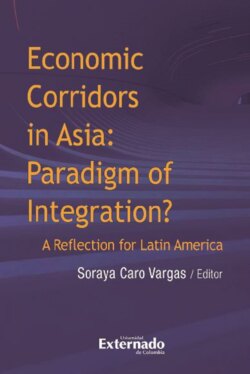Читать книгу Economic corridors in Asia : paradigm of integration? A reflection for Latin America - Varios autores - Страница 30
На сайте Литреса книга снята с продажи.
INTRODUCTION
ОглавлениеEconomic corridors are a means for promoting investment, optimally utilizing resources and accelerating economic development within the national and sub-regional geography. It can be functional through developing ports, highways, freight corridors and an efficient transportation system. The primary objective of economic corridors is to provide facilitating mechanisms for promoting competitiveness and efficiency which includes reduced distribution costs and addressing land procurement complexities. Economic corridors promote industrial development through identifying the underutilized zones and exploiting the potential to meet development challenges within a target region. Therefore, economic corridors are the lifelines of a nation’s growth capacity as well as a promotion plan for future exports. For India, which has had a socialist welfare economy since its independence, the last three decades have shown a slow transition to a liberal market economy. Therefore, for the growth of the manufacturing sector, economic corridors are prerequisites to long-term growth.
According to the Economic Survey of India 2017-2018, the services sector accounts for 54.40 per cent of India’s total Gross Domestic Product (GDP) while the industrial sector contributes 29.73 per cent followed by the agriculture and allied sector’s share of 15.87 per cent (statisticstimes.com, n.d.). Economic corridors create the necessary foundation for the focused growth of manufacturing and production centers through facilitating measures such as tax breaks, cheap land and easy import procedures to set up the industrial zones. Furthermore, they create the necessary economic super structure with ancillary units and a seamless connectivity between centers of economic activity, so that maximum capital and labor efficiency can be achieved.
Therefore, the question arises as to whether India needs to focus at this juncture on economic corridors and the reasons for this. India has been witnessing a better than average growth of 6.5-7.5 per cent for the last five years (2014-2018) (IMF, 2018) and given this momentum, it has become imperative for India to explore its export-led industrialization possibilities and also facilitate Foreign Direct Investment (FDI) from both private and institutional investors. In the past, the common reasons for slow investment in India and also the concentrated FDI in select states, cities or Union territories such as Mumbai, Delhi, Bangalore, Chennai, Ahmedabad and Hyderabad attracting 75 per cent of total FDI (Department of Industrial Policy and Planning, n.d.) was due to the comparative development pattern and ease of access to the resources and bureaucracy. This is because of a relatively better infrastructure as well as legal and other aspects which have made these regions a more preferred destination. In order to address this lopsided development, making the development of an infrastructure a priority as well as addressing the challenges involved with the environment, acquisition of lands and the time-bound process of development. . There has been due stress within the Indian establishment (Niti Aayog, 2018) to integrate land use and infrastructure connectivity within India and its integration with its immediate neighbors (NITI Aayog, 2015) as a means of benefitting the region and integrating India into sub-regional networks. India has been focusing not only at land-based physical infrastructure development but is giving due consideration to digital connectivity and maritime connectivity and has embarked on such projects with the Association of Southeast Asian Nations (ASEAN) and the Bay of Bengal Initiative for Multi-Sectoral Technical and Economic Cooperation (BIMSTEC) countries. Before discussing the role of economic corridors in the Indian context, it is important to evaluate it from a theoretical perspective.
